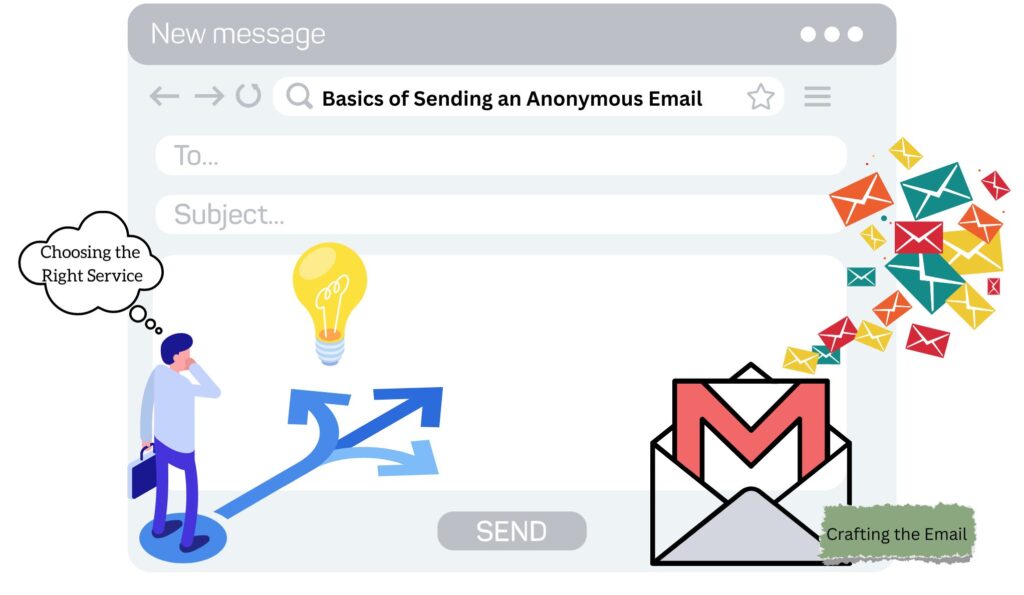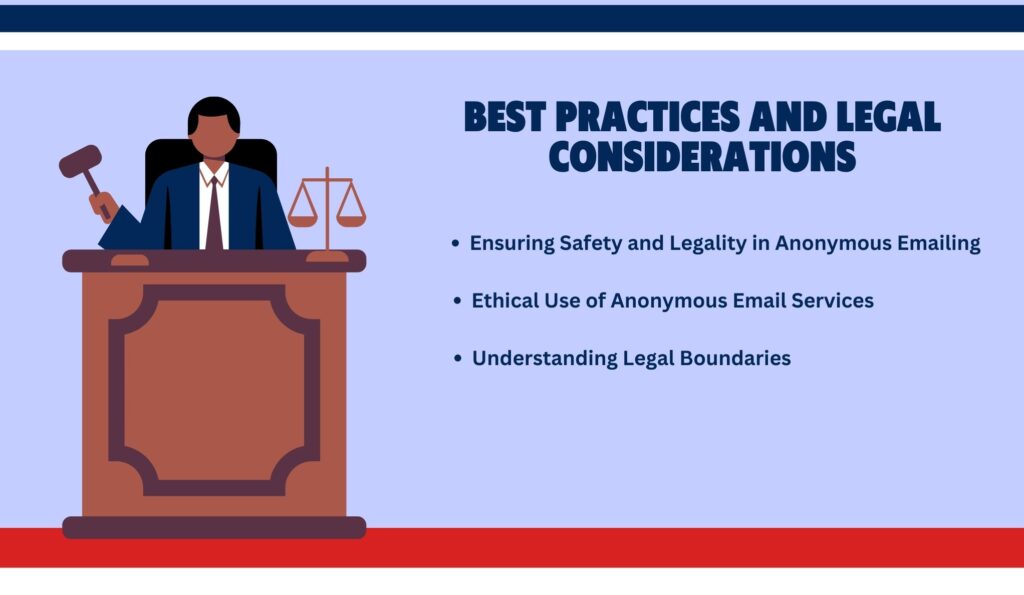Email has become a cornerstone of modern communication, evolving with technology to meet our diverse needs. Among its many facets, anonymous emailing stands out as a unique tool. It serves a multitude of purposes, from protecting personal information to ensuring privacy in sensitive matters. As we increasingly value our digital privacy, understanding the role and method of anonymous emailing has never been more crucial.
What is Anonymous Emailing?
Anonymous emailing refers to the process of sending emails without revealing your true identity. It’s a method employed by individuals and organizations alike to maintain privacy, avoid spam, or communicate sensitive information without the risk of being traced.
Why Choose to Send Emails Anonymously?
- Privacy: In an age where data breaches and privacy concerns are rampant, keeping your identity hidden can provide a significant layer of protection.
- Avoiding Spam: By using anonymous emails, you can prevent your primary email address from being targeted by spam and marketing emails.
- Sensitive Communication: Whether it’s whistleblowing or a private confession, anonymous emails offer a secure way to communicate sensitive information.
Basics of Sending an Anonymous Email
Sending an anonymous email isn’t as complex as it might seem. It involves selecting a service that allows you to send emails without registering personal details, or masking your identity in various ways.

- Choosing the Right Service: There are many platforms available that provide anonymous email services. Some require no personal information at all, while others offer temporary email addresses.
- Crafting the Email: When composing an anonymous email, it’s crucial to avoid including any personal information, either in the email body or the email settings, that could be traced back to you.
Ensuring Your Email Remains Anonymous
Maintaining anonymity requires more than using the right service. You must also be mindful of the content of your emails and any metadata that might be included.
- Content Caution: Be careful with the information you share in the email body. Avoid any details that could indirectly reveal your identity.
- Understanding Metadata: Emails carry metadata, such as IP addresses, that can potentially be traced. Using services that mask or remove this metadata is essential for true anonymity.
How to Send an Anonymous Email
Sending an anonymous email can seem daunting at first, but by following a structured approach, it becomes a straightforward process. This section will guide you through the necessary steps, ensuring your identity remains concealed while you communicate effectively.
Step-by-Step Guide to Sending Anonymous Emails
To begin sending anonymous emails, you need to follow a few key steps. These include selecting a suitable email service and understanding the essentials of crafting an email that protects your identity. By adhering to these steps, you can send emails anonymously with confidence and ease.
Choosing the Right Anonymous Email Service
The first step in sending an anonymous email is selecting the appropriate service. There are numerous options available, each offering different levels of anonymity and features.
- Prioritize Privacy Features: Look for services that do not require personal information for account creation. Privacy-focused email services often have features like encryption and minimal data logging.
- Consider Service Reliability: Choose a service known for its reliability and uptime. A good anonymous email service should deliver your messages promptly without any technical issues.
Tips for Crafting an Anonymous Email
After selecting your email service, the next step is to write your email. There are several important considerations to ensure your email remains anonymous.
- Avoid Personal Information: Do not include any personal details in your email. This includes names, locations, or any information that could be traced back to you.
- Be Mindful of Your Writing Style: Your writing style can sometimes reveal your identity. Try to write in a neutral tone and avoid unique phrases or slang that could be associated with you.
Common Types of Anonymous Email Services
The world of anonymous email services is varied, offering different features to meet diverse needs. In this section, we’ll look at some common types of anonymous email services, each catering to specific requirements and preferences.
Exploring Various Anonymous Email Platforms
Choosing the right anonymous email platform depends on what you need from the service. Some people might prioritize ease of use, while others might need advanced features like the ability to send attachments. Understanding the different types available helps you make an informed decision.
Free Anonymous Email Services
For those who need to send an anonymous email occasionally without any cost, free anonymous email services are a great option.
- Advantages: The primary advantage is that these services are free. They are also typically easy to use, requiring no sign-ups or personal information.
- Limitations: On the downside, free services might have limitations in terms of features, like limited storage or lack of advanced security measures.
Anonymous Email Services with Attachments
Some situations require sending attachments anonymously. There are services specifically designed for this purpose, balancing anonymity with functionality.
- Features to Look For: When choosing a service for sending attachments, look for one that offers encryption and large file support while still keeping your identity hidden.
- Use Cases: These services are ideal for whistleblowers, journalists, or anyone needing to share sensitive documents without revealing their identity.
Using Gmail for Anonymous Emails
While Gmail is not inherently anonymous, it can be used to send emails without revealing your true identity, with some careful steps.
- Creating an Anonymous Account: You can create a Gmail account without using your real details. However, remember to avoid any personal identifiers.
- Considerations: Keep in mind that Gmail tracks IP addresses, so you might want to use a VPN or similar service to mask your location.
Best Practices and Legal Considerations

When it comes to anonymous emailing, it’s not just about keeping your identity hidden. It’s also crucial to use these services responsibly and understand the legal implications. This section focuses on best practices for safe and legal use of anonymous email services.
Ensuring Safety and Legality in Anonymous Emailing
Using anonymous email services requires a balance between maintaining privacy and adhering to legal standards. It’s important to be aware of both the ethical and legal aspects to avoid potential issues.
Ethical Use of Anonymous Email Services
The ethical use of anonymous email services is paramount. While these services offer privacy, they should be used responsibly.
- Respect for Privacy: Use anonymous emails in a way that respects others’ privacy and avoids harm.
- Avoiding Misuse: It’s important not to use these services for illegal activities, harassment, or sending harmful content.
Understanding Legal Boundaries
Anonymous emailing operates within certain legal boundaries, and it’s essential to be aware of these.
- Compliance with Laws: Understand that while anonymous emailing is legal, it should not be used for illegal activities. Laws regarding digital communication vary by country and region.
- Legal Consequences: Misusing anonymous email services can lead to legal consequences. It’s important to use these services within the bounds of the law.
Advanced Tips for Anonymous Emailing
For those who require a higher level of anonymity in their email communications, there are advanced techniques and strategies that can be employed. This section delves into these methods, providing insights on how to further protect your identity and handle common privacy concerns.
Enhancing Anonymity in Email Communication
Achieving greater anonymity in email communication involves more than just using an anonymous email service. It requires a comprehensive approach that considers all potential vulnerabilities.
Advanced Techniques for Maintaining Anonymity
To enhance your anonymity beyond basic measures, consider the following advanced techniques:
- Use Encrypted Email Services: Services that offer end-to-end encryption can add an extra layer of security, keeping your messages private.
- Utilize VPNs and Proxies: These tools can mask your IP address, making it more difficult for your location to be tracked.
- Temporary Email Addresses: For one-time communications, using a temporary or disposable email address can be effective.
Dealing with Email Tracing and Privacy Concerns
One of the biggest challenges in anonymous emailing is avoiding email tracing and addressing privacy concerns.
- Be Aware of Metadata: Emails contain metadata like the sender’s IP address, which can be traced. Use services that strip this information.
- Regularly Update Security Measures: Keep up-to-date with the latest privacy tools and practices. This includes using secure browsers and being aware of the latest cybersecurity threats.
Troubleshooting Common Issues
Even with the best practices in place, users of anonymous email services might encounter certain challenges. This section aims to address some of the common issues faced and provide practical solutions to ensure smooth and secure anonymous emailing.
Solving Common Challenges in Anonymous Emailing
Encountering problems while sending anonymous emails can be frustrating. Understanding how to troubleshoot these issues can enhance your experience and ensure your communications remain uninterrupted and secure.
Addressing Delivery Issues
One of the frequent challenges in anonymous emailing is ensuring the successful delivery of emails. If your emails are not reaching their intended recipients, consider these steps:
- Check for Typos in Email Addresses: A simple typo can lead to delivery failure. Double-check the recipient’s address for accuracy.
- Verify Service Reliability: Some anonymous email services might have issues with server reliability. If consistent problems occur, consider switching to a more reliable service.
Handling Security Alerts and Filters
Security alerts and email filters can sometimes block or flag anonymous emails. To mitigate this:
- Avoid Trigger Words: Certain words or phrases in your email might trigger spam filters. Keep your language neutral and avoid using terms commonly associated with spam.
- Understand Email Filters: Recipients’ email services may have strong filters. Inform your recipients to check their spam or junk folders if they are expecting an anonymous email.
Conclusion
In the digital age where privacy is increasingly valued, understanding how to send anonymous emails is a crucial skill. This guide has provided comprehensive insights into the various aspects of anonymous emailing, from choosing the right service to handling common issues.
By adhering to the best practices and legal considerations, individuals can leverage the power of anonymous emailing for secure and private communication. The advanced tips offered in this guide further enhance the ability to maintain anonymity, ensuring that your identity and information remain protected.
Remember, the key to successful anonymous emailing lies in being informed, cautious, and responsible. Whether it’s for personal privacy or professional discretion, the ability to send anonymous emails empowers users to communicate freely while safeguarding their identity.








